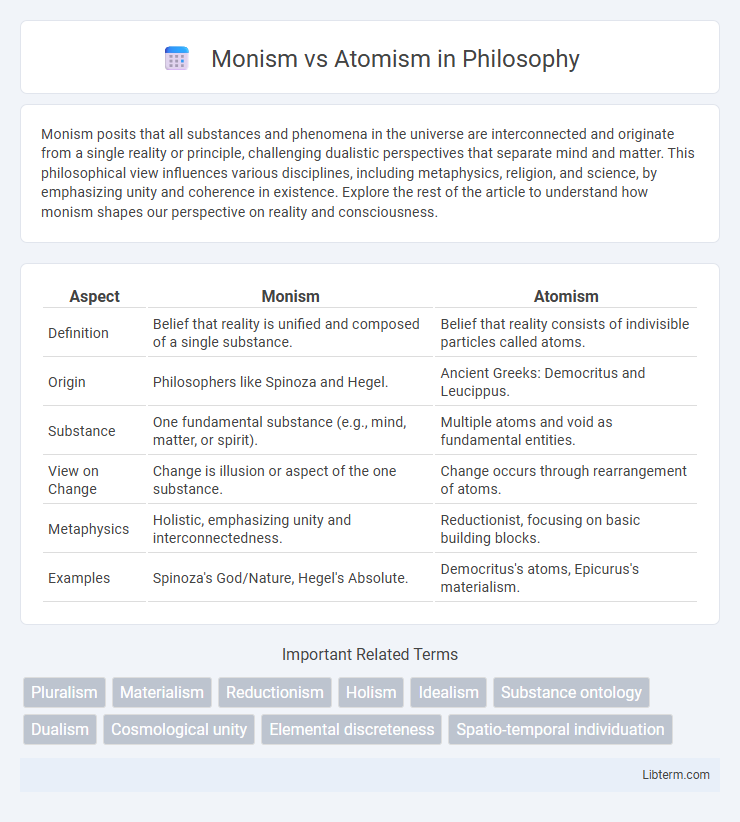Monism posits that all substances and phenomena in the universe are interconnected and originate from a single reality or principle, challenging dualistic perspectives that separate mind and matter. This philosophical view influences various disciplines, including metaphysics, religion, and science, by emphasizing unity and coherence in existence. Explore the rest of the article to understand how monism shapes our perspective on reality and consciousness.
Table of Comparison
| Aspect | Monism | Atomism |
|---|---|---|
| Definition | Belief that reality is unified and composed of a single substance. | Belief that reality consists of indivisible particles called atoms. |
| Origin | Philosophers like Spinoza and Hegel. | Ancient Greeks: Democritus and Leucippus. |
| Substance | One fundamental substance (e.g., mind, matter, or spirit). | Multiple atoms and void as fundamental entities. |
| View on Change | Change is illusion or aspect of the one substance. | Change occurs through rearrangement of atoms. |
| Metaphysics | Holistic, emphasizing unity and interconnectedness. | Reductionist, focusing on basic building blocks. |
| Examples | Spinoza's God/Nature, Hegel's Absolute. | Democritus's atoms, Epicurus's materialism. |
Introduction to Monism and Atomism
Monism is a philosophical doctrine asserting that all reality is unified in a single substance or principle, often emphasizing the interconnectedness of all things. Atomism, in contrast, posits that the universe consists of indivisible, discrete units called atoms whose combinations form the complexity of matter and existence. These foundational perspectives in metaphysics shape debates on the nature of reality, consciousness, and the fundamental structure of the cosmos.
Historical Origins and Key Philosophers
Monism and Atomism, two foundational metaphysical theories, originated in ancient Greek philosophy with distinct views on the nature of reality. Monism, championed by philosophers like Parmenides and later Spinoza, posits that reality is a single, unified substance or principle, emphasizing oneness and continuity. Atomism, founded by Leucippus and Democritus, argues that everything is composed of indivisible tiny particles called atoms moving through the void, laying the groundwork for classical physics and materialism.
Defining Monism: Unity of Reality
Monism posits that all existence is grounded in a single, unified reality, rejecting the fragmentation of substances or entities. This philosophy emphasizes the interconnectedness of all things, asserting that diversity arises from one fundamental essence or principle. By defining reality as an indivisible whole, Monism contrasts sharply with Atomism, which views reality as composed of discrete, independent atoms.
Understanding Atomism: Plurality of Substances
Atomism posits that the universe is composed of multiple indivisible and eternal substances called atoms, which combine in various ways to form all matter and phenomena. This plurality of substances contrasts with monism, which asserts that reality consists of a single fundamental substance or principle. Atomism emphasizes the diversity and multiplicity of basic entities as the foundation of the physical world and its complex interactions.
Major Arguments For and Against Monism
Major arguments for Monism emphasize the unity of all existence, arguing that reality is composed of a single substance or principle, which simplifies the metaphysical framework and avoids the problem of explaining interactions between different substances. Critics argue that Monism struggles to account for the diversity and complexity of phenomena, as it tends to overlook the distinct, irreducible elements observed in nature. Opponents also contend that Monism cannot adequately explain the subjective experiences and plurality evident in consciousness and physical reality, making Atomism's division into fundamental particles a more plausible account of the universe's structure.
Major Arguments For and Against Atomism
Atomism argues that all matter consists of indivisible particles called atoms, explaining natural phenomena through their interactions and motion. Critics claim atomism oversimplifies reality by ignoring the continuity and qualitative aspects of matter, which monism addresses by emphasizing an underlying unified substance or principle. Defenders of atomism highlight its predictive power in modern science and empirical validation in atomic theory, while detractors point to philosophical challenges regarding consciousness and the nature of existence beyond physical atoms.
Comparative Analysis: Monism vs Atomism
Monism posits that reality is composed of a single substance or principle, emphasizing unity and coherence, whereas Atomism asserts that all matter consists of indivisible atoms moving in a void, highlighting multiplicity and material composition. Monism often aligns with idealism or pantheism, suggesting an interconnected existence, while Atomism supports a mechanistic and scientific worldview grounded in physical processes. The comparative analysis reveals Monism's strength in explaining holistic phenomena, contrasting with Atomism's empirical approach to understanding the discrete components of the universe.
Influence on Science, Religion, and Philosophy
Monism's influence on science is evident in holistic approaches, emphasizing interconnectedness in fields like ecology and quantum physics. In religion, monism underpins traditions such as Advaita Vedanta and certain mystical branches, promoting unity between the divine and the self. Atomism shapes scientific methodologies through reductionism and empirical analysis, while in philosophy, it fosters materialist perspectives and challenges metaphysical dualism.
Contemporary Perspectives and Debates
Contemporary perspectives on Monism vs Atomism explore the fundamental nature of reality through the lens of modern physics and philosophy, with Monism emphasizing a unified, singular substance underlying existence, while Atomism supports a composition of discrete, indivisible entities. Advances in quantum mechanics and cosmology challenge traditional Atomistic models by revealing entanglement and non-locality, prompting debates on whether reality is best described as a holistic field or a collection of particles. Philosophical discourse integrates these scientific insights, questioning the boundaries of materialism and exploring consciousness as a potential bridge between Monist unity and Atomist plurality.
Conclusion: Relevance in Modern Thought
Monism and atomism continue to influence contemporary philosophy and science by shaping debates on the nature of reality and consciousness. Monism's emphasis on unified existence aligns with holistic approaches in quantum physics and systems theory, while atomism's focus on discrete components underpins reductionist methodologies in biology and chemistry. Understanding their relevance helps bridge metaphysical perspectives with empirical research, fostering interdisciplinary insights into the structure of the universe.
Monism Infographic

 libterm.com
libterm.com